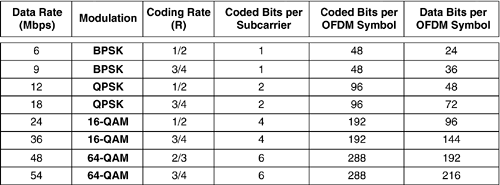Summary of IEEE 802.11 PHYs
| The naming of the various PHYs defined in the context of IEEE 802.11 is not as descriptive as one might hope. The original RF-based PHYs were named Frequency Hopping Spread Spectrum (FHSS) and Direct Sequence Spread Spectrum (DSSS). In addition to these RF-based PHYs, the IEEE 802.11-1999 specification also specified a diffuse infrared PHY. All of those PHYs operate at either 1 or 2 Mbps. There was no specific "marketing" name for the 1 and 2 Mbps PHYs, other than "IEEE 802.11." IEEE 802.11aThe IEEE 802.11a-1999 standard specifies a "High-Speed Physical Layer in the 5 GHz Band." To quote the standard, the following describes the actual attributes of IEEE 802.11a PHYs:
Figure 3-20 shows which modulations are used to achieve which speeds. The "coding rate" expresses the parameters governing forward error correction at a given speed. Figure 3-20. OFDM modulations and their resulting speeds[28]
There are actually 12 non-overlapping channels that have been specified in IEEE 802.11a, of which eight contiguous channels occupy the "lower" U-NII band, and a disjoint four contiguous channels occupy the "upper" U-NII band. The increased number of non-overlapping channels is a significant deployment advantage for WLANs based on IEEE 802.11a, since it is possible to overlay many more APs in the same physical space. IEEE 802.11bThe IEEE 802.11b-1999 standard is called "Higher Speed Physical Layer Extension in the 2.4 GHz Band." The IEEE 802.11b PHYs are commonly known as the "High Rate" (or simply "HR") PHYs, and include two different modulation choices in the 2.4 GHz band. The mandatory modulation scheme is known as Complementary Code Keying (CCK), and an alternate scheme is also defined, known as Packet Binary Convolutional Coding (PBCC). Both of these defined modulation schemes support operation at two speeds: 5.5 and 11 Mbps. IEEE 802.11b is defined to operate between 2.401 GHz and 2.4835 GHz, which is a proper subset of the 2.4 GHz ISM band in the United States, and which is also similarly available for unlicensed use in many other parts of the world. The channel definition within the 2.4 GHz band, as specified in IEEE 802.11b-1999, allows for three non-overlapping channels: Channel 1, Channel 6, and Channel 11. The complete name for the CCK PHYs is "High Rate Direct Sequence Spread Spectrum" (or HR/DSSS). They are "high rate" compared to plain DSSS that was defined by the original IEEE 802.11-1999, which operated at either 1 or 2 Mbps. There is an optional variant of HR/DSSS that uses the Short PLCP Preamble, which is known as HR/DSSS/short. In addition, there are two names for the PBCC-based PHYs, namely HR/DSSS/PBCC and HR/DSSS/PBCC/short, wherein the PLCP Header is preceded by the optional Short Preamble. In all these cases, the PLCP Header is modulated such that any STA could understand it, to enable backward compatibility, so the PLCP header is modulated at either 1 Mbps or at a combination of 1 and 2 Mbps. The Short Preamble variants defined in IEEE 802.11b-1999 are able to be demodulated by DSSS STAs, but since there was no Short Preamble option defined at that time, these STAs would not be able to parse the PLCP Preamble of these frames. IEEE 802.11dIEEE 802.11d-2001 is not a PHY standard, but it is very deeply related to the IEEE 802.11b standard, so it is worth mentioning here. The IEEE 802.11d standard, entitled "Amendment 3: Specification for operation in additional regulatory domains," provides mechanisms that can enable products based on IEEE 802.11b-1999 to roam across differing regulatory domains. Based on information conveyed by an IEEE 802.11d-capable AP, an IEEE 802.1d-capable STA will learn the regulatory domain in which it is operating, and thereby cease using channels that are not legal to use in that domain. IEEE 802.11gIEEE 802.11g-2003 adds the OFDM modulations based on IEEE 802.11a-1999 to the lower-cost radios of IEEE 802.11b-1999. It also extends the PBCC modulation, which optionally was defined to operate at 5.5 and 11 Mbps in IEEE 802.11b-1999, to the speeds of 22 and 33 Mbps. Additionally, a hybrid modulation is provided which uses the DSSS-style PLCP header, with OFDM-modulated data. The PHYs in the IEEE 802.11g standard are known as "Extended Rate PHYs" and have the following names:
The Short Preamble support, which was optional-to-implement in IEEE 802.11b, is mandatory-to-implement in IEEE 802.11g. The AP decides when it is safe to enable that mode of operation (e.g., when most, or all, of the associated STAs are ERP-STAs). IEEE 802.11g-2003 specifies rules to help the ERP-STAs safely interoperate with HR-STAs.
|
EAN: 2147483647
Pages: 60
